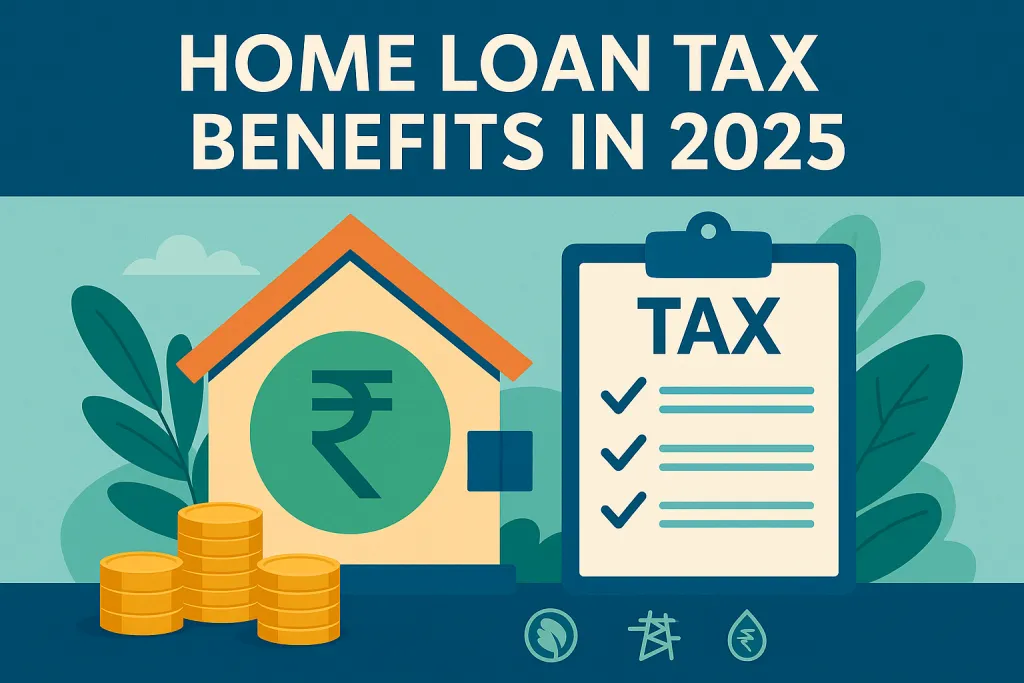Maximize Your Home Loan Tax Benefits in India 2025: Guide & Updates

Home loan tax benefits in India have become more rewarding in 2025, with significant relief for borrowers under both the old and new tax regimes. The Union Budget 2025 introduced key enhancements, especially in the deduction available on interest payments, making home ownership more tax-efficient for a wide range of taxpayers.
Interest Paid on Home Loan (Section 24b)
Under Section 24(b), the deduction limit for interest paid on housing loans has been increased to ₹3 lakh per annum for self-occupied properties.
This is a substantial jump from the previous ₹2 lakh limit, providing an additional ₹1 lakh in deductible interest. For someone in the 30% tax bracket, this could mean annual tax savings of up to ₹30,000.
There is no upper limit on interest deduction for properties that are let out or deemed to be let out, although the set-off for loss from house property is capped at ₹2 lakh per year as per the Income Tax Act.
The loan must be for purchase or construction of a property, and the construction should be completed within five years from the end of the financial year in which the loan was taken.
Principal Repayment (Section 80C)
You can claim up to ₹1.5 lakh per year under Section 80C on the principal repaid, as part of your home loan EMIs.
The deduction is only available after the house construction is complete, and the property is in your possession.
The property must not be sold before five years from the end of the financial year in which possession was obtained; otherwise, deductions claimed earlier will be reversed.
This ₹1.5 lakh limit is shared with other Section 80C investments, including PPF, ELSS, life insurance, and EPF.
Extra Deductions for First-Time Home Buyers
Section 80EE allows an additional deduction of up to ₹50,000 per financial year on interest paid for first-time buyers, if the loan amount does not exceed ₹35 lakh and the value of the property is less than ₹50 lakh.
Section 80EEA provides an extra deduction of ₹1.5 lakh per year for loans sanctioned up to March 31, 2026, for affordable homes (stamp value up to ₹45 lakh), provided the individual does not own any other residential property.
Note: Benefits under 80EE and 80EEA are not available together claim the best one applicable based on your circumstance.
Benefits for Joint Home Loans
In case of joint loans and co-ownership, each co-borrower can individually claim the full deduction for both principal (up to ₹1.5 lakh each) under Section 80C and interest (up to ₹3 lakh each) under Section 24b, proportionate to their share and repayment contribution.
This effectively doubles the overall tax benefit for joint owners, making co-borrowing an attractive proposition for families.
Applicability Under Tax Regimes
Traditionally, these deductions were available only under the old tax regime.
However, with the 2025 Budget, the government extended special home loan interest deductions under the new regime as well, with a limit of ₹1.5 lakh for self-occupied property. This makes the new tax regime more competitive for homeowners.
Why These Changes Matter
Most home loans in India are large amounts repaid over 15–25 years. The EMI’s interest component is highest in the initial years, so raising the deduction limit helps new buyers secure meaningful tax relief.
The enhancements especially benefit mid- to upper-middle-class families, first-time home buyers, and those investing in affordable housing.
Example Calculation
On a ₹50 lakh home loan at 7.99% for 20 years:
Interest paid in the first year: ₹3.95 lakh.
Old maximum deductible: ₹2 lakh (leaving ₹1.95 lakh non-deductible).
New limit: ₹3 lakh so only ₹95,000 is not deductible, resulting in significant tax savings.
Summary Table: Key Tax Benefits Available
Section | Component | Maximum Deduction | Eligibility | Special Notes |
|---|---|---|---|---|
24(b) | Interest | ₹3 lakh/year | All borrowers | Up from ₹2 lakh w.e.f. 2025 |
80C | Principal | ₹1.5 lakh/year | After construction, 5-year lock-in | Shared with other 80C investments |
80EE | Interest | ₹50,000/year | First-time, loan < ₹35 lakh, prop < ₹50 lakh | |
80EEA | Interest | ₹1.5 lakh/year | Affordable homes, sanction by 31 Mar 2026 | Not with 80EE |
24(b) – New Regime | Interest | ₹1.5 lakh/year | Self-occupied in new regime | Budget 2025 change |
Looking forward
These targeted deductions reduce taxable income, increasing the affordability of home ownership for a vast number of Indian families.
Looking ahead to 2026, the future of home loan tax benefits in India may see a notable shift as the new tax regime becomes the government’s default choice for taxpayers. While the current regime offers robust exemptions for principal and interest repayment, in the new regime, these specific home loan deductions may not be available for self-occupied properties. However, property owners with let-out homes can still offset losses from house property against other income, providing indirect benefits. As financial institutions and policy makers adapt, there is ongoing debate about reintroducing or revising targeted housing incentives, especially to support affordable housing and first-time buyers. This evolving landscape means borrowers should stay updated with each budget cycle, as potential regulatory tweaks could redefine home ownership’s tax implications in India for 2026 and beyond.








